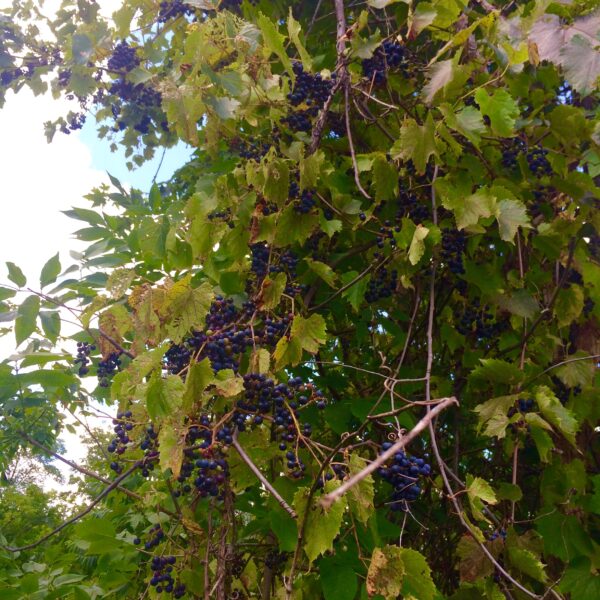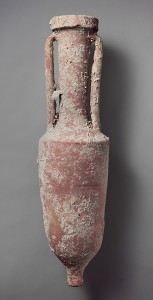
CAMDEN VALLEY ROAD runs east-west from Sandgate, Vermont across the state line into Washington County, New York. It’s a winding, two-lane country road with hardly any traffic on it, and it’s partially for this reason that my wife and I walk it every day when staying nearby.
The other reason is that it’s exceptionally picturesque – edged with hay and corn fields, cow pastures, high meadows that rise into the surrounding mountains, unused silos, falling-down farm buildings and, for most of its length, wild grapevines that have attached themselves to trees along the roadway.
Wondering at these lofty, limb-borne vines day after day set me thinking about their longstanding relationship with trees and how the interaction of the two has been instrumental in shaping our ideas of what quality wine tastes like.
The grape vine is a natural climber, an adaptation that saves it the trouble of forming a trunk sturdy enough to support itself. In the ancient world, wine vines were trained to grow up trees – poplars and elms, typically. It was dangerous work for those who had to literally go out on a limb to prune the vines and harvest the fruit. As part of their labor contract vine dressers were provided with the guarantee of a paid-up funeral.
While the plane trees that line many European backroads induce nostalgia in us, the first century Roman poet Horace was disheartened to see these purely ornamental trees (“around which no vine will ever twine”) displacing his beloved elms. Horace loved the country as only an urban refugee can. His Sabine farm was a gift of the poet’s patron, Maecenas, to whom he addressed frequent complaints about how things were everywhere going to the dogs.
As part of their labor contract vine dressers were provided with the guarantee of a paid-up funeral.
To train vines to supporting elms, or to bundle the old canes collected during pruning called for sturdy cordage. To provide it, wine growers planted willows whose long, strong, flexible branches did the trick. Willows served another vineyard purpose, as I learned when I visited Deirdre Heekin at her little vineyard and cantina in Barnard, Vermont. As a means of countering a high water table in the single acre of vineyard that surrounds their home she and her husband Caleb Barber planted willows whose ability to draw up vast amounts of water via their roots is proverbial. “Vines don’t like to have their feet wet,” she likes to say.
A much less obvious connection between trees and vines is visible in the use the ancient world made of plant resins to both preserve and flavor wine. Marcius Portius Cato, writing in the third century BCE discusses at length the value of lining storage vessels with tree pitch. It served the dual purpose of making them leak-proof and introducing an anti-spoilage agent.
Of course, the ancients had no notion of bacteria as the cause of wine ‘going off’ — that had to wait for the work of Pasteur in the 19th century — but tree resins were already known to have preservative powers and for this reason were often used in the treatment of wounds. The resin of the common terebinth tree (Pistacia terebinthus) did for ordinary applications. Myrrh and frankincense were exotic specialty resins used in the making of perfume and embalming ointments.
Cato doesn’t discuss the influence pitch-lined casks had on wine flavor, but two centuries later Gaius Pliny offered an extensive treatment of the kinds of flavoring agents used in contemporary winemaking, specifically mentioning tree pitch as making an important contribution – “acrid” and “smoky” are the words he uses to describe it. Sections of Book XIV of his Historia Naturalis that deal with preservation techniques confirm that, over time, methods used to preserve wine influenced notions of how quality wine tastes..
By the third century, the Romans had established vineyards in northern Europe, where the romance of the tree and the vine took a new turn – in the form of wooden barrels replacing clay amphora as the most common storage medium for wine. It was another case of steps taken with a view to preserving wine having the long term effect of altering benchmarks of taste and quality. Barrels made their own contribution to the character of wine by supplementing primary fruit flavors with woody notes and with tannins that added structure and texture.
Today we have lots of ways of getting the woody notes we’ve learned to love into wine (oak staves, nuggets, beads, sawdust) but even these techniques are hardly newfangled. In his agricultural treatise published in 1600, Olivier de Serres suggested that cadging wood chips from the local carpenter and adding them to barrels made wine last longer and taste better – adding that every savvy innkeeper in France knew the trick.
But even then the tree wasn’t done doing favors for the vine. The cork tree is also an oak, and the marriage of the cork stopper and glass bottle in the eighteenth century revolutionized the way wine was purchased, stored, and enjoyed. For the first time an individual with very little room could store wine long-term in a single serving container that facilitated slow, even maturation of its contents and didn’t put the whole of the owners’ stock in jeopardy when it was cracked open.
Over the next couple of centuries the tandem effectively shifted British tastes away from the relatively simple flavors of fresh wine toward the more complex experiences provided by (particularly) Bordeaux and Port that had spent decades in bottle.
No, wine doesn’t grow on trees – but it wouldn’t be the same without them.
Reach me at stephenmeuse@icloud.com
Follow @stephen_meuse
